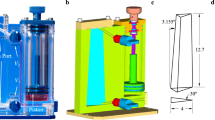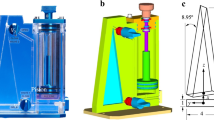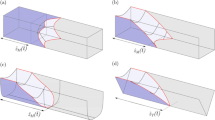Abstract
Drop towers continue to provide unique capabilities to investigate capillary flow phenomena relevant to terrestrial and space-based capillary fluidics applications. In this study certain ‘capillary rise’ flows and the value of drop tower experimental investigations are briefly reviewed. A new analytic solution for flows along planar interior edges is presented. A selection of test cell geometries are then discussed where compound capillary flows occur spontaneously and simultaneously over local and global length scales. Sample experimental results are provided. Tertiary experiments on a family of asymmetric geometries that isolate the global component of such flows are then presented along with a qualitative analysis that may be used to either avoid or exploit such flows. The latter may also serve as a design tool with which to assess the impact of inadvertent container asymmetry.
Similar content being viewed by others
References
Bolleddula, D.: Capillary flow analysis and computation of dewetting and wetting resistances in angular geometries. Master’s thesis, Portland State University (2007)
Brakke, K.A.: Surface evolver program. Exp. Math. 1, 141–165 (1991)
Concus, P.: Static menisci in a vertical right circular cylinder. J. Fluid Mech. 34, 481–495 (1968)
Concus, P., Finn, R.: On the behavior of a capillary free surface in a wedge. Proc. Natl. Acad. Sci. 63, 292–299 (1969)
Dong, M., Chatzis, I.: The imbibition and flow of a wetting liquid along the corners of a square capillary tube. J. Colloid Interface Sci. 172, 278–288 (1995)
Dreyer, M., Delgado, A., Rath, H.J.: Capillary rise of a liquid between parallel plates under microgravity. J. Colloid Interface Sci. 163, 158–168 (1994)
Finn, R.: Equilibrium Capillary Surfaces. Springer, New York (1986)
Klimek, R., Wright, R.: Spotlight-8 image analysis software. NASA Tech. Memo. 2006-214084, Glenn Research Center, Cleveland (2006)
Lekan, J., Gotti, D., Jenkins, A.J., Owens, J.C., Johnston, M.R.: Users guide for the 2.2 second drop tower of the NASA Lewis Research Center. NASA Tech. Memo. TM-107090 (1996)
Masica, W.J., Derduhl, J.D., Petrash, D.A.: Hydrostatic stability of the liquid-vapor interface in a low-acceleration field. NASA Tech. Note D-2444 (1964)
Masica, W.J., Petrash, D.A., Otto, E.W.: Hydrostatic stability of the liquid–vapor interface in a gravitational field. NASA Tech. Note D-2267 (1964)
Mayer, F.J., McGrath, J.F., Steele, J.W.: A class of similarity solutions for the nonlinear thermal conduction problem. J. Phys., A, Math. Gen. 16, 3393–3400 (1983)
Ramé, E., Weislogel, M.M.: Gravity effects on capillary flows in sharp corners. Phys. Fluids 21, 042106–042106-12 (2009)
Semerjian, B.: Capillary flow in interconnected interior corners and other exciting adventures. Master’s thesis, Portland State University (2009)
Siegel, R.: Transient capillary rise in reduced and zero-gravity fields. J. Appl. Mech. 83, 165–170 (1961)
Siegert, C.E., Petrash, D.A., Otto, E.W.: Time response of liquid–vapor interface after entering weightlessness. NASA Tech. Note D-2458 (1964)
Stange, M., Dreyer, M.E., Rath, H.J.: Capillary driven flow in circular cylindrical tubes. Phys. Fluids 15, 2587–2601 (2003)
Tavan, N.: Critical geometric wetting phenomena: study of capillary driven flow in the CFE vane gap experiment aboard the international space station. Master’s thesis, Portland State University (2009)
Weislogel, M.M.: Capillary flow in containers of polygonal section. AIAA 39, 2320–2326 (2001)
Weislogel, M.M., Collicott, S.H.: Capillary re-wetting of vaned containers: spacecraft tank rewetting following thrust resettling. AIAA 42, 2551–2607 (2004)
Weislogel, M.M., Lichter, S.: A spreading drop in an interior corner: theory and experiment. Microgravity Sci. Technol. IX, 175–184 (1996)
Weislogel, M.M., Lichter, S.: Capillary flow in an interior corner. J. Fluid Mech. 373, 349–378 (1998)
Weislogel, M.M., Jenson, R., Bolleddula, D.: Capillary driven flows in weakly 3-dimensional polygonal containers. In: AIAA-2007-748, 45th AIAA Aerospace Sci. Meeting and Exhibit, Reno, Nevada, 8–11 January 2007
Weislogel, M.M., Ross, H.D.: Surface reorientation and settling in cylinders upon step reduction in gravity. Microgravity Sci. Technol. III, 1 (1990)
Author information
Authors and Affiliations
Corresponding author
Rights and permissions
About this article
Cite this article
Bolleddula, D.A., Chen, Y., Semerjian, B. et al. Compound Capillary Flows in Complex Containers: Drop Tower Test Results. Microgravity Sci. Technol. 22, 475–485 (2010). https://doi.org/10.1007/s12217-010-9213-x
Received:
Accepted:
Published:
Issue Date:
DOI: https://doi.org/10.1007/s12217-010-9213-x




